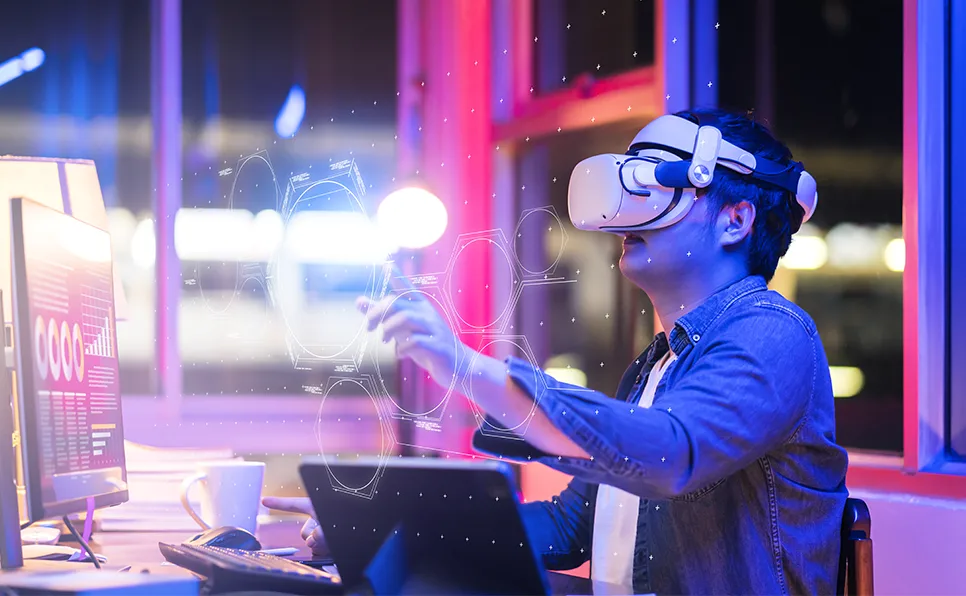Introduction
Virtual reality (VR) technology has come a long way in recent years and is no longer just a gimmick. With advancements in hardware and software, VR has become a powerful tool for experiencing life in new and exciting ways. This technology is rapidly advancing, and it’s changing the way we experience life. From exploring new worlds to learning new skills, VR provides an entirely new level of immersion and creativity.
In this blog post, we’ll explore how virtual reality is changing the way we see the world and how it’s providing a new level of immersion and creativity.
What is Virtual Reality?
Virtual Reality (VR) is a technology that creates a computer-generated simulation of a three-dimensional (3D) environment that can be interacted with in a seemingly real or physical way by a person using special electronic equipment, such as a headset, gloves, or body suit. VR technology is designed to immerse the user into an alternate world where they can interact with digital objects and environments as if they were physically present. The technology is built using a combination of hardware and software that generates a lifelike experience by simulating sight, sound, touch, and even scent.
How Does Virtual Reality Work?
Virtual reality works by tricking the brain into perceiving a digital environment as real. This is achieved by generating an immersive experience using a headset that covers the user’s eyes and ears, creating the illusion of being in a virtual world. The headset uses sensors to track the user’s movements and adjust the virtual environment in real-time, allowing the user to interact with digital objects and environments as if they were physically present.
Additionally, VR systems can also use hand-held controllers or body suits to allow for more complex interactions, such as grabbing and manipulating virtual objects, or simulating physical movements like walking or running. The combination of hardware and software creates a seamless and convincing experience that can be used for various purposes such as gaming, education, therapy, and more.
Differences Between Virtual Reality and Traditional Forms of Entertainment
Virtual reality offers a level of immersion that is not possible with traditional forms of entertainment such as video games, movies, or television.
In traditional forms of entertainment, the user is passive and watches the action unfold on a screen. In VR, the user is an active participant, able to interact with the virtual environment in a natural and intuitive way.
Virtual reality also offers the potential for a more personal and tailored experience, as the user’s actions and decisions can affect the outcome of the virtual experience.
Unlike traditional forms of entertainment, virtual reality can also provide a social aspect, allowing users to interact with others in virtual environments, opening up new possibilities for communication and collaboration.
Unlike traditional video games or movies, VR allows users to experience a completely new world with their own senses. With the use of VR headsets and hand-held controllers, users can look around and interact with their virtual surroundings as if they were there.
How is Virtual Reality Changing the Way We Experience Life?
Virtual reality has the potential to revolutionize the way we experience life, by offering new and immersive ways to explore, learn, play, and interact with the world. VR is no longer just for gaming and entertainment, but has found applications in fields such as education, healthcare, and even military training. With the advancements in VR technology, we can experience things imagine in the past, breaking down the barriers of time and space, and making the world a smaller place. As VR continues to evolve, it holds the promise to transform our lives and how we engage with the world around us.
One of the most exciting aspects of virtual reality is its potential for education and training. With VR, students can learn about subjects in a way that is both engaging and memorable. For example, instead of reading about the human body in a textbook, students can use VR to explore and interact with the different systems and organs in a way that makes the information more accessible and memorable.
In addition, virtual reality is being used to help people overcome phobias, such as fear of heights or public speaking. By gradually exposing patients to their fears in a controlled virtual environment, they can learn to overcome their anxieties and lead a more fulfilling life.
The Benefits of Virtual Reality
Virtual reality offers many benefits, including:
- Immersive experiences: VR offers a level of immersion that is not possible with traditional forms of entertainment. With VR, users can become completely immersed in new worlds and experiences, making them feel as if they are really there.
- Increased creativity: Virtual reality opens up new avenues for creative expression and personal growth. From exploring new landscapes to creating new worlds, VR provides endless opportunities for creativity and imagination.
- Improved education and training: VR has the potential to revolutionize the way we learn and train for new skills. By providing immersive and interactive experiences, VR makes learning more engaging and memorable.
- Overcoming phobias: VR is being used to help people overcome their fears and phobias. By exposing patients to their fears in a controlled virtual environment, they can learn to overcome their anxieties and lead a more fulfilling life.
Applications of Virtual Reality in Day-To-Day Life
-
Gaming
Virtual reality has revolutionized the gaming industry by offering a highly immersive and interactive experience that traditional gaming methods cannot match. VR gaming allows players to physically move around, interact with objects, and experience game environments in a way that feels real, providing a new level of excitement and engagement. The gaming industry has embraced VR, developing a wide range of games that take advantage of the technology, from action and adventure games to puzzle and simulation games.
-
Education and Training
Virtual reality has the potential to revolutionize the way we learn and train, providing a highly engaging and interactive way to acquire new skills and knowledge. VR environments can simulate real-life scenarios, allowing students and trainees to practice and develop their skills in a safe and controlled environment. For example, medical students can use VR to practice surgeries or procedures, while soldiers can use it to simulate real-life combat scenarios and improve their tactical skills. Virtual reality also offers new ways to teach and learn, making it possible to experience and interact with digital models and simulations in a way that is not possible with traditional forms of education.
-
Therapy
Virtual reality has shown great promise as a therapeutic tool, offering a way to treat mental health conditions such as anxiety, phobias, and post-traumatic stress disorder. By exposing patients to simulations of traumatic events or phobia-inducing scenarios in a controlled and safe environment, therapy using VR has the potential to help patients overcome their fears and challenges in a way that is not possible with traditional forms of therapy. Additionally, VR can be used to help patients with conditions such as chronic pain, offering a way to distract from the pain and provide a more positive and engaging experience.
-
Entertainment and Media
Virtual reality has opened up new possibilities for entertainment and media, offering a highly immersive and interactive way to experience movies, television shows, music, and more. VR can transport users to digital environments and worlds, allowing them to experience and interact with characters, stories, and events in a way that feels real. The entertainment industry is exploring the potential of VR, developing a range of content that takes advantage of the technology, from VR movies and music videos to live concerts and events.
The Future of Virtual Reality
Virtual reality technology is rapidly evolving, with new advancements being made all the time. In the future, VR technology is expected to become even more advanced, providing even greater levels of immersion, interactivity, and realism. Other advancements in VR technology include improvements in hardware such as more advanced head-mounted displays and haptic feedback systems, as well as the development of new software and platforms that allow for even more seamless and intuitive VR experiences.
With the rapid advancement of virtual reality technology, there are many new and innovative uses for VR that are yet to be explored. For example, virtual reality has the potential to revolutionize industries such as healthcare, education, and retail, by providing new ways to diagnose and treat patients, learn and train, and shop and purchase goods. Additionally, VR has the potential to create entirely new industries and forms of entertainment, as well as to shape the way we live, work, and interact with each other.
Conclusion
Virtual reality is a powerful tool for experiencing life in new and exciting ways. Its potential for education, personal growth, and creativity makes it a truly innovative technology that is sure to change the way we see the world. As VR technology continues to advance, we can expect to see even more amazing uses for virtual reality in the years to come.



